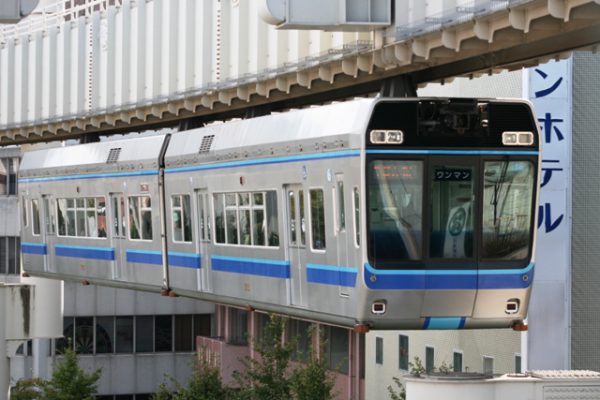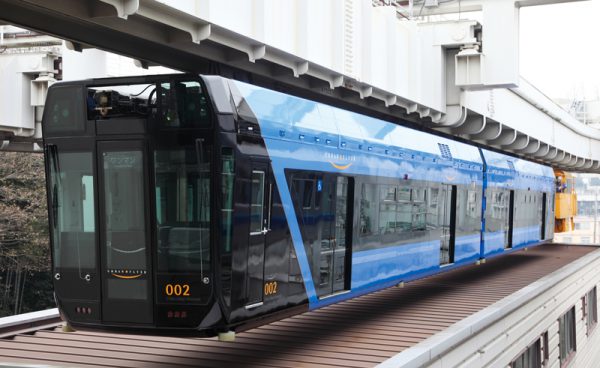
Last week we looked at some possible future trends in urban motor coach transportation – those that rode on good ole’ terrestrial mother earth. But there is another mass transit option that due to a variety of factors, may offer a cost effective supplement to buses and light rail – a form of elevated railway; the monorail. Monorails derive their name from the single beam that provides coaches both support and guidance.


Why and how are monorails cost effective? Two main reasons; first, they typically follow an existing right-of-way, such as a large street, requiring space only for the supporting pillars, and second, stations are built vertically over these right-of-ways, again lessening the footprint (and cost).
Here in Japan, where urban congestion and high land prices limit expanding roadways or adding new rail lines, monorail systems have proven both popular and profitable. Let’s take a quick look at two…

The Tokyo Tama Line is fortunately fairly near our home – no station is nearby but it intersects with several other rail commuter lines that are close. Opened in 1998, the system serves western Tokyo with a total of 19 individual stations over a 19 kilometer route.

The Tama Line is a “straddle” type monorail – where the coach sits on the guiderail (in comparison to a “suspended” type with the guiderail above).


The coaches are built by Hitachi, and this design has been standardized for all straddle-type monorails in Japan – they are approximately 3 meters wide and 63 meters long. Each car as two bogies, with 4 rubber tired drive-wheels per bogie. The horizontal wheels secure the coach to the beam, and serve as guides.


A typical train consists of four coaches with a total passenger load of 632 – 156 seated. Trains can reach speeds of 60 mph.


Our other monorail is in Chiba Prefecture, east of Tokyo, sitting opposite Tokyo Bay. Chiba City is served by the “Townliner” – a “suspended” monorail, which is the longest such system in the world. Built in 1988, it currently extends for 16 kilometers with 18 stations – and a new 2 km extension is under study.

There are several different types of suspended systems – Chiba uses the SAFEGE design; a hollow steel box that serves as the support and guiderail – the bogies are contained within this box. Contrary to what one may assume, SAFEGE isn’t a product of General Electric – the acronym actually stands for the French consortium Société Anonyme Française d’ Etude de Gestion, which first developed this design in the 1960s. This system works well in locations with frequent inclement weather – as the drive assemblies and guiderail are protected from the elements.



Coaches are constructed by Mitsubishi – new, updated models were introduced in 2012. Trains run in pairs and max speed is 50 mph.
The Chiba monorail has very high ridership rates.
The Tokyo Tama Line also has expansion plans – on the books is an extension with an end terminal just a few blocks from our home – it’s one of the transportation initiatives for the 2020 Tokyo Olympics. Good timing, as by then I’ll be eligible for my senior citizen “Golden Card” discount…

Fun Fact: Ever wonder why monorail systems today appear rather boxy, and nothing like the futuristic, streamlined models similar to the one at Disneyland? Well, while those old designs looked great from the outside, inside they were very cramped. The bogies, other drive systems, auxiliary controls, etc., all intruded into the passenger area. Rather than a flat floor, these large protrusions limited space, hindered passenger flow, and made for awkward seating. Modern straddle coaches like those on the Tama Line put all those components under the floor and on the sides, maximizing the cabin area, but resulting in a somewhat boxy, bland design.





















I always associate monorails (and flat-screen TVs) with the 1966 movie adaptation of Ray Bradbury’s “Fahrenheit 451.”
That one was the first SAFAGE monorail.
This is a suspension monorail; Wuppertal, the 1st, is still in use for public transport. My only experience with this type is the “novelty” one at the LA County Fairground (AKA Fairplex), now dismantled. It had nice big windows for sightseeing below.
Ref: http://www.monorails.org/tMspages/archive080206.html
Don’t know which one I would like to see. Living in Edmonton, I can appreciate having the guide covered from the elements it’s just looking up at the bottom of a train as it passes. Probably put advertising on the bottom. Also, I would imagine servicing the bogies is difficult. Need to have a dedicated, covered depot for that.
Somebody is going to post this eventually, so:
Thanks! “Disneyland” is the first thing I think of when I hear “monorail,” but this is right behind it.
I took an intensive three week course on this subject, I learned “mono” means one and “rail” means rail.
Then you’ll also have noticed that this isn’t really a monorail. It has separate left and right tracks, with the outer box serving the purpose of the girders in a classical tram rail.
I’m not saying it isn’t cool, it is, but it isn’t a monorail, it’s a regular suspension railway.
This was my instant association as soon as I saw the title 🙂
I’d like to note that you can’t catch Mono from a monorail.
I hear “chipmunks” audio in parts of that video of the Chiba monorail. Was it sped up a little?
It’s running at 2x speed.
Seattle has a monorail that extends from the downtown area to what was formerly the World’s Fair, now called Seattle Center. Built in 1962 by ALWEG, it has been a nearly flawless operation. There are two parallel beams and the cars shuttle back and forth between the two terminals. There was talk of extending the line but nothing ever came of it.
Ive been on the Sydney monorail a few times its different all right compared to some of the ancient red rattlers that were then still in service relics from the 20s but still running on the western line, my sister and hubby are touring in Japan right now and loving the high speed trains, 300kph/186mph cruising speed sounds like fun to me too.
The Sydney monorail was demolished a few years ago. I rode on it probably 20 years ago, it may have been useful to go from one end of the CBD to the other but instead it did a big one-way loop to a shopping centre adjacent the city that made it good for tourists but not as useful as it could have been.
That in-car footage is mesmerizing. I rode the Disneyland Monorail in 1984 expecting something sleek and futuristic, but it seemed slow and creaky.
I sometimes wonder if the Disney monorail actually set back the development of monorail transit systems in the US, because anyone proposing to build one is open to a derisive attack that they are proposing an amusement park ride. The one thing the Disney monorail has definitely accomplished is that everyone who goes to Disney comes home knowing at least one sentence in Spanish: “Mantengase alejado de las puertas.”
Thank you for this. Such system would have been perfect for Tel Aviv but no, the powers that be decided to go for a conventional (on and underground) system thereby ensuring pure hell for everyone digging up the city for the next 5 years and thereafter.
For anyone interested, https://en.wikipedia.org/wiki/Tel_Aviv_Light_Rail
At the risk of armchair quarterbacking, I suspect “contract milking” explains the duration of such projects. It took over a year for Tucson to remodel one intersection near our home, whereas LA rebuilt freeways damaged by the 1994 Northridge Earthquake within 3mo. because they offered $200K/day schedule incentives to the contractor. Maybe not all financing should be this extreme, but there’s a lesson here.
Spot on. But it also adds to the delays if you stubbornly chose the wrong mode.
I was commuting from Sunland to Valencia when the Northridge earthquake happened. The 14 overpass collapsed onto I-5, and the only way around this section was San Fernando road from Foothill Blvd to Valencia. For about a week it took 2 to 3 hours each way to get to and from work, crawling along with all the I-5 traffic including trucks crawling along at walking pace. A bypass to the Old Road was built in about a weeks time, and traffic was able to dive around the construction. I was amazed that the huge overpass and roads could be rebuilt so quickly! Shows what can be done when bullshit and boondoggery is not an option in a major artery rebuild.
On the other hand, I was commuting from Vancouver to Beaverton for 3 years, and ODOT was working at a snails pace doing construction on the US-26 around Canyon Road. I think the whole project took about 5 years.
There was an effort that almost went through to replace the I-5 drawbridge that crosses the river between Oregon and Washington, and light rail from Portland was a part of this effort. It was pointed out that I-205 had been built with light rail in mind, and went right next to Portland International Airport as well. Light rail already exists in this area, why not use this crossing? The east side of Vancouver which I-205 runs through is where light rail is needed, not the west side. The feeble answer was it would make the freeway shoulders too narrow! After wasting about 200 million dollars on this effort, the bridge was a no go because people did not want the huge expense building a bridge with light rail underneath it. A replacement bridge without light rail (which would have had one station into sleepy westside downtown Vancouver) would not be considered by the powers that be, so for now it’s been rejected.
Chicago should of had a Monorail system like this long ago replacing the ancient EL
systems that has been used since the early 1900s.
Problem is the corrupt politicians skim off billions to line their own pockets………